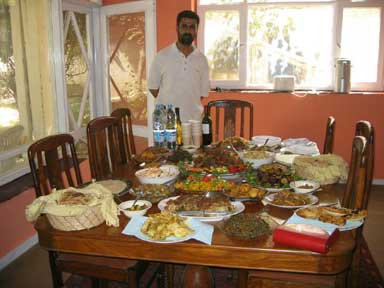 |
| A table of Afghan food. Photo by Tracy Hunter. |
We hosted dinners multiple nights a week, mostly for friends, but often for dignitaries including ambassadors, three-star generals, heads of UN agencies and other development agencies. Highlights include the two Thanksgivings we hosted for over thirty people for a traditional, sit-down, Thanksgiving meal, most recent one even boasting real sweet potatoes and home-made fresh cranberry sauce (courtesy of a shopping trip to Dubai).
Most importantly, our kitchen in Kabul was a safe haven where we could be together, in peace, and forget about the challenges weighing on us, as was the case on October 26, 2009, when the Taleban attacked a United Nations Guesthouse in Kabul. After ensuring the safety of friends and colleagues, we retreated to our kitchen to bake. You can read more about this experience on my blog, “Foodie in a Warzone” here. McClatchy Newspapers’ website published an article about cooking as a coping mechanism in dangerous times here.
Though we rarely cooked Afghan meals ourselves, we enjoyed many great meals dinners and breakfasts with our Afghan friends, and fell in love with local favorites such as shula, manto, asheq and of course Kabuli pilau. You can read more about these meals on my blog here and here.
At the end of three years in Afghanistan, and two years of cooking and eating in Kabul, we are sad to leave our beloved kitchen and friends behind, but excited to be moving on to yet another adventure in Timor Leste. We have had some of the most amazing meals in Kabul, and are immensely grateful to our Afghan hosts for sharing their food and their country with us. Our blog, Foodie in a Warzone lives on and will continue to follow our culinary crusade through our questionable choices of locales.
Susan Marx was born and raised in South Africa. She is a humanitarian aid worker who recently completed three years in Afghanistan. In addition to being an avid cook, she is a private pilot, advanced scuba diver, mountain biker and snowboarder.
Radish, Ginger, and Nuts with Blue Cheese
I discovered the most delicious radishes in Kabul and developed a minor obsession with this spicy ingredient, which lead me to develop the following recipe:
1 teaspoon butter
2 cups radish (use either quartered red radishes, or sliced and quartered daikon radishes)
1 cup white wine
½ cup pecans or walnuts, quartered
1 teaspoon brown sugar
1 teaspoon freshly chopped ginger
Toppings:
2 tablespoons crumbled blue cheese
Minced parsley
Heat the butter in a pan. When it has melted, add the radishes.
Sauté until they sizzle in the pan, then pour in about ½ cup of white wine.
Add the pecans or walnuts to the pan, along with the brown sugar. Sauté for about 10-15 minutes, adding more wine as it is absorbed.
Add the brown sugar and ginger, then sauté another 2-3 minutes.
When the radishes are soft, remove from heat, toss in the blue cheese, top with parsley and serve warm.
Serves 4
Heat scale: mild
Wilted Chinese Cabbage
For a variation, or to make a more substantial salad course, serve the radish salad over wilted Chinese cabbage:
2 tablespoons butter
1 medium onion, chopped
2 cloves garlic
1 cup white wine
1 head of Chinese cabbage, separated, rinsed
Fresh cumin seeds (use powdered if you don’t have fresh)
Salt & Black pepper
Melt the butter in a wok or other large pan, add the onion and sauté until translucent.
Add the garlic and sauté for an additional 1-2 minutes.
Add the wine and bring to a boil, then add the cabbage all at once (don’t worry, it shrinks). Use a pair of tongs to turn the cabbage in the pan as it cooks.
When the cabbage has wilted down, add a sprinkle of cumin, then salt & pepper to taste.
Serve the wilted cabbage on a plate, topped with the radish salad.
Serves 4
Heat scale: mild





